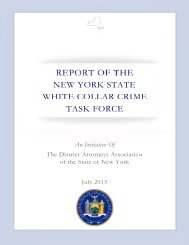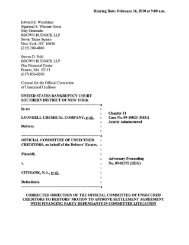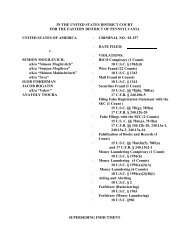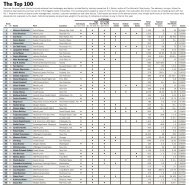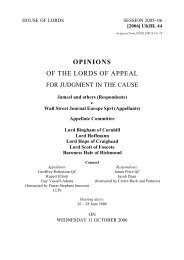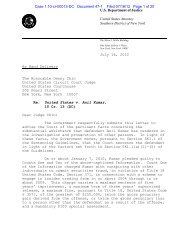Salz Review - Wall Street Journal
Salz Review - Wall Street Journal
Salz Review - Wall Street Journal
Create successful ePaper yourself
Turn your PDF publications into a flip-book with our unique Google optimized e-Paper software.
185<br />
<strong>Salz</strong> <strong>Review</strong><br />
An Independent <strong>Review</strong> of Barclays’ Business Practices<br />
cultures defined by overly commercial and competitive features at the expense of all else<br />
are at the root of major corporate failure. Other research by Corporate Philosopher, Roger<br />
Steare 274 , supports this hypothesis, pointing to cultures which lack the ethic of ‘care’.<br />
In such cultures, research shows an increase in fear-driven compliant behaviour at the<br />
expense of doing the right thing. Steare argues that the modern corporation is a relic of<br />
feudal thinking in which power ultimately derives from wealth. His research points to<br />
evidence that these pseudo-democratic organisations are prone to cultural dysfunction,<br />
with profit pursued at the expense of a higher order purpose. This, he concludes, is a root<br />
cause of corporate failure.<br />
Regulators have also pointed the finger at culture, describing unacceptable culture as a root<br />
cause of the recent financial crisis. 275 Regulators need healthy bank cultures to enable them<br />
to do their work effectively. They can never have sufficient resources to monitor every bit<br />
of the banks’ work, so culture is the crux to ensuring that organisations comply not just<br />
with the law but with the spirit too. Markets rely on rules and laws, but those rules and laws<br />
in turn depend on truth and trust. 276 Better cultures should require less regulation, fewer<br />
laws and fewer regulators.<br />
Culture takes time to create, is enduring and resistant to change and is almost impossible to<br />
copy. It is this which can make culture an organisation’s most valuable (or value<br />
depreciating) asset. For employees, culture can be a key component of the decision to stay<br />
with one organisation instead of seeking work in another. It is the social glue that delivers<br />
discretionary effort at work, and it is this which makes culture a valuable construct.<br />
How Groups Carry Culture<br />
To truly understand how culture is created through shared learning, it is necessary to<br />
understand the basics of groups and how group norms are created through the processes<br />
of group formation and shared learning. There are basic socio-psychological forces that<br />
operate in all of us (need to achieve, need for affiliation/relationships and need for<br />
influence). 277 These are the raw materials around which people organise to accomplish tasks<br />
and to create viable, socially comfortable organised groups to which members feel aligned.<br />
Groups typically develop in stages. Each stage requires the group to solve the questions of<br />
purpose (what are we here to do); member identity (why am I/we part of this group and<br />
how do we fit together); mechanisms of influence (what is my role); and how to manage<br />
both feelings of frustration and caring through the norms of authority and intimacy (how<br />
do we get things done and what does it feel like to be part of this group). Norms are<br />
developed as these questions are answered. Values and associated behaviours and patterns<br />
of interaction that work for the group, helping the group accomplish its tasks, gradually<br />
over time become cultural assumptions. The stages that a group progresses through are not<br />
exactly linear, but do typically follow a pattern, resolving matters of purpose, authority and<br />
intimacy in this order.<br />
274 www.MoralDNA.org.<br />
275 Hector Sants speech, “Do regulators have a role to play in judging culture and ethics?”, 17 July 2010.<br />
276 Charles Handy, What’s a Business For?, 2002.<br />
277 David C. McCelland, Human Motivation, 1987.






